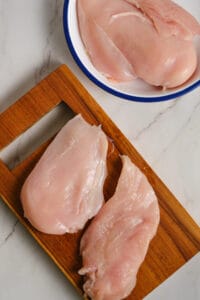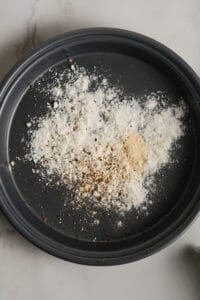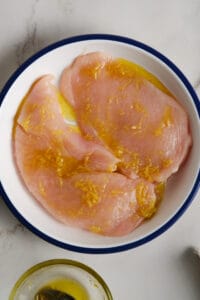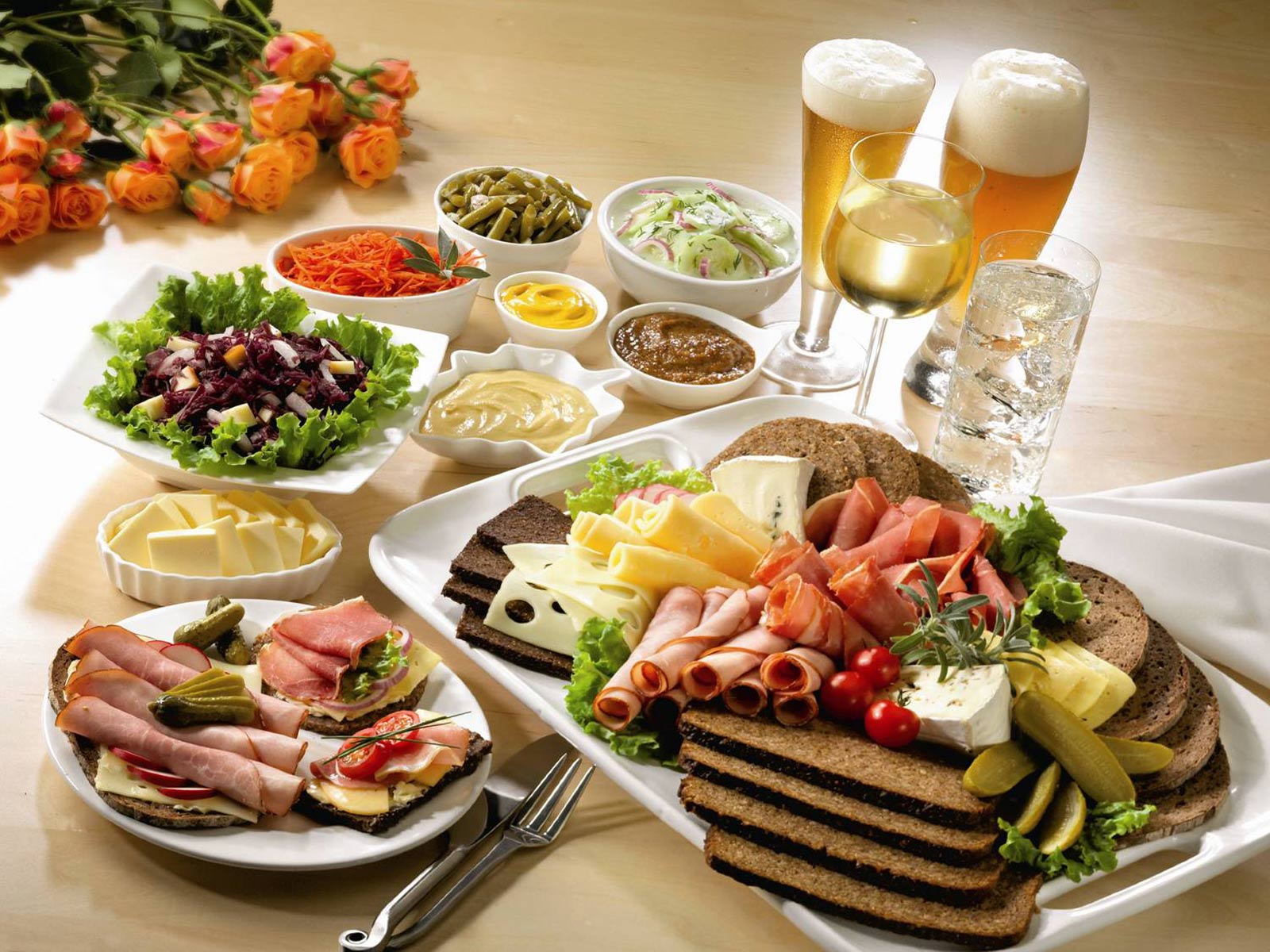Whether you want to contribute a secret recipe or an article to our blog section - we'd love to hear from you! Please feel free to reach out at [email protected] so that we can spread the yummy goodness of saffron recipes together. Join us in our mission to promote sustainable eating habits and share the joy of cooking with everyone!
For now, love yourself and enjoy this one ...
Now love yourself and enjoy this one ...
Give your poultry a citrus burst and a sharp kick of spice with this recipe for the Best Lemon-Pepper Chicken.

Table of Contents
I started with a wing.
That was when I was introduced to the wonders of chicken flavored with lemon and pepper. It was one of those weekly Wing Nights at my local bar where they charge you an obscenely scant amount per wing—a loss leader intended to get you through the door to buy lots of beer. I fall for it every time. I eat a handful of wings then me and my friends go through more pitchers than we had planned.
But not this time. Nope. It was all about those wings. Especially the lemon-pepper ones. They were a recent addition to the wings menu and I had low hopes. Lemon and pepper sounds too… basic. Did I still think they were basic 20 wings in? Nope.
Since that night I have used lemon and pepper on a number of occasions with a number of dishes (homemade potato chips and flaked tuna, anyone?). But the most successful is this lemon-pepper chicken, which makes sense given it was on chicken that I originally had it. Luckily for you, you don’t have to ‘wing’ it; you have this recipe to steer you to a delicious and healthy meal your family will love.
Is Lemon-Pepper Chicken Healthy?
Yes, pretty much all the ingredients provide some nutritional benefit. The chicken has protein, the lemon has vitamin C and antioxidants, and the olive oil has monounsaturated fats. The only question surrounds the all-purpose flour. As a refined grain, it limits the amount of diets this recipe is suitable for. Using almond flour instead, for instance, would make it accessible to those on gluten-free, low-carb, and paleo diets.
Should I Use Lemon Juice as well as Lemon Zest?
The zest contains citrus oils, which will infuse your chicken with a lovely lemon flavor. It will also smell amazing. But there are benefits to using lemon juice as well as/in lieu of the zest. For starters, lemon juice contains acids, which will help tenderize the chicken. Being a liquid, it will also add moisture—no small feat when dealing with a meat that is prone to overcooking. Just don’t marinate with lemon juice too long; it could turn the texture to mush.
INGREDIENTS
- 2 boneless, skinless chicken breasts (8-10 oz. each)
- 2 fresh lemons
- 1 tbsp olive oil
- 3 tbsp all-purpose flour
- 1/2 to 3/4 tsp salt
- 2 1/2 tsp cracked black pepper
- 1/2 tsp garlic powder
- fresh parsley (for garnish)

INSTRUCTIONS
Prepare
Slice and pound the chicken for even thickness. Zest the lemons, avoiding the white pith.
Coat
Mix lemon zest with olive oil and slather onto the chicken.
Dredge
Combine flour and seasonings, then coat the chicken evenly.
Cook
Sear the chicken in hot oil until golden on both sides.
Garnish & Serve
Add parsley and lemon slices if desired, and enjoy your meal!
Devour!

FAQs & Tips
Yep, you can make up the marinade and coat the chicken with it. Then cover it up or put it in an airtight container and keep it in the fridge for up to eight hours ahead of cooking time. I typically prep the chicken on a Saturday morning, knowing it will be good to go come dinner time.
Pounding your chicken isn’t just a rage management technique; it produces meat that is all uniformly sized. And when your breasts are all the same size, they will cook at the same rate. You should also let the chicken rest after taking it from the oven. This allows its juices to redistribute and the internal heat to finish off the chicken. If you find your chicken’s finishing is ‘lopsided’, this could be why.
Yes, you can. Be it the breast (as used in this recipe), the wing (you already know how I feel about lemon-pepper chicken wings), drumsticks, thighs, and even the whole bird. It also doesn’t matter how you cook them, either. In a pan, the oven, on the grill… it will all taste great.
Use a meat thermometer. Insert it into the thickest part of the chicken. It’s done once it has reached 165°F internal temperature.
You totally can. Unsurprisingly, the skin will add more flavor. Just rub the lemon zest mix on the skin AND the meat itself. This way, you’ll taste it with every bite. Then dredge it through the flour mix.

Serving Suggestions
Chicken is a much-loved entree for a number of reasons, one of which is its ability to go with any side, be it mashed potatoes, rice, or vegetables, like this Corn on the Cob. Heck, pair it with a slice of pizza, it will still work out. What I try to do is side it with dishes that will taste great with lemon and pepper flavor, so I make a bit more of the zest-oil mix then add grated pepper. It brings a flavor consistency to the meal and I don’t have to worry about any clashes that might force my guests to eat the entree in full, take a glass of water to cleanse the palate, then start on the sides.


The Best Lemon Pepper Chicken
Ingredients
- 2 boneless skinless chicken breasts (approximately 8-10 ounces each)
- 2 fresh lemons
- 1 tbsp olive oil
- 3 tbsp all-purpose flour
- 1/2 to 3/4 tsp salt
- 2 1/2 tsp cracked black pepper
- 1/2 tsp garlic powder
- fresh parsley (for garnish)
Instructions
- Slice each chicken breast horizontally to create two thinner cutlets. For even cooking, lightly pound them to a uniform thickness of about 1/2 inch.

- Grate the zest from the lemons to yield 1 1/2 to 2 tablespoons of zest, being careful to avoid the bitter white pith.

- Combine the lemon zest with 1 tablespoon of olive oil in a bowl. Coat the chicken cutlets thoroughly with the lemon oil mixture.

- In a shallow dish, whisk together the flour, salt, black pepper, and garlic powder.

- Dredge each lemon-oil coated chicken cutlet in the flour mixture, shaking off any excess.

- Heat the remaining olive oil in a skillet over medium-high heat. Cook the chicken for 2 minutes a side, or until golden and cooked through.
- If desired, thinly slice the zested lemons and briefly cook the slices in the skillet until caramelized.
- Garnish the cooked chicken with fresh parsley and serve immediately. DEVOUR!
Nutrition
The post The Best Lemon-Pepper Chicken appeared first on Food Faith Fitness.
References:
By: FoodfaithfitnessTitle: The Best Lemon-Pepper Chicken
Sourced From: www.foodfaithfitness.com/lemon-pepper-chicken/
Published Date: Mon, 18 Mar 2024 16:56:14 +0000
Frequently Asked Questions
How can I determine if my produce was organic?
These three labels can help you make sure you're buying organic produce.
USDA Organic Certified – Produced by USDA and certified as 100% organic.
Certified Naturally Grown - Produce that has passed strict requirements for organic practices but has not yet received certification from the USDA.
Pastured/Free Range - Produce from animals who live outdoors and graze freely on grass and herbs.
These labels are used to indicate that the product meets specified criteria.
- No synthetic fertilizers or pesticides
- No genetically altered organisms
- The animal is never given antibiotics
- No hormones are ever given to the animal
- No growth-promoting drugs
- No feed additives
- No artificial ingredients
- No irradiation
- There's no sewage waste sludge
- GMOs are not allowed
- Antibiotics have never been administered
- No hormones ever given
- There are no growth-promoting drugs
- No feed-additives
- No artificial ingredients
- No sewage sludge (if it's a non-GMO)
- No irradiation
I hope you found this article helpful.
What are organic foods and how do they compare?
Organic produce can be grown without the use of pesticides or synthetic fertilizers. No growth hormones are used. Animal testing is also not done. These crops are allowed to grow naturally, so farmers do not use chemicals to prevent weeds or pests.
Organic farming practices help maintain soil quality and reduce erosion. Organics contain more nutrients than regular food and are therefore better for our overall health. Organic foods are often higher in fiber, lower in fat, and less calories than those produced conventionally.
What are the best organic vegetables for you?
Organic vegetables are the highest quality and healthiest food source. They are among the most nutritious foods on Earth.
Organic produce can be grown without the use of pesticides herbicides fungicides and chemical fertilizers. These chemicals can be dangerous to our environment as well as our health.
Organic produce also has more nutrients, vitamins minerals, antioxidants and phytonutrients. They also contain more fibre, essential fatty acids, enzymes, fiber, and enzymes. This makes them healthier because we absorb these nutrients better when eating organics.
Not only do organic vegetables taste delicious, but they are also safe to eat. Organic produce does not have side effects.
Any grocery store can sell organic fruits and vegetables. They can be labeled organic if they are grown according to USDA guidelines.
What are my top priorities when buying organic products
USDA-certified organic labels are recommended. This seal signifies that the product meets specific USDA standards. Look out for the USDA Organic seal on boxes, cartons cans and jars.
When shopping for meat, ensure it comes from cows fed 100% organic feed. Cattle are ruminants. This means they chew the cud. Ruminant cattle are divided into four stomach compartments, the rumen and reticulum as well as the omasum and abmasum. To be labeled '100% organic, all animal parts must be organically nourished.
You should only purchase chicken that has been raised organically. It must not have ever been treated with antibiotics. Chickens can eat both animal and plant food. Omnivorous chickens have a digestive tract composed of a crop, proventriculus, gizzard, small intestine, large intestine, and anus.
It is important to ensure that dairy products are from cows that were fed 100% organic feed. Dairy cows have four stomach compartments, just like ruminants. The fourth stomach compartment, the udder, is where milk comes from.
If you are buying other types of livestock, make sure to check the label to determine the percentage of their diet. For example, pork may be labelled '95% organic.' This means 95 percent of the pig's feed came from organic sources.
Statistics
- Nutrients like omega-3 fatty acids were up to 50 percent higher in organic meats and milk than in conventionally raised products.[3] (en.wikipedia.org)
- When packaged products indicate they are “made with organic [specific ingredient or food group],” they contain at least 70% organically produced ingredients. (usda.gov)
- Popular clothing brands, like Patagonia, are labelled as organic by using 100 percent organic cotton for many of their styles. (en.wikipedia.org)
- Brands participating in this challenge are committed to using 100 percent sustainable cotton by 2025.[5] (en.wikipedia.org)
External Links
[TAG36]
- PubMed: Assessment of the micronutrients found in plant foods that are produced using organic and conventional agricultural techniques - PubMed
- Comparison of the total phenolic and ascorbic acid content of freeze-dried and air-dried marionberry, strawberry, and corn grown using conventional, organic, and sustainable agricultural practices - PubMed
[TAG39]
[TAG42]
- EWG's 2022 Shopper's Guide to Pesticides in Produce
- Clean Fifteen(tm) Conventional Produce with the Least Pesticides
[TAG45]
- A Review of Journal of Toxicology and Environmental Health: Cancer Risk and Occupational Pesticide Expositions: Part B: Vol 15, Number 4
- Genetically modified foods: Safety, Risks and Public Concerns - A Review - Journal of Food Science and Technology
How To
Organic foods: Are they safer and more nutritious?
Organic food is produced without chemical pesticides or synthetic fertilizers. They are grown in natural environments without artificial inputs (fungicides/herbicides/hormones, antibiotics or genetic engineering). Organic farming practices include crop rotation, cover crops, composting animal manure, recycling wastewater, and integrated pest management (IPM).
The USDA National Organic Program (NOP) was established in 2002 to regulate the production, handling, processing, labelling, sale, and distribution of organic products sold in the United States. NOP regulations make sure that organic agricultural product conforms to the Federal Food, Drug, and Cosmetic Act. Additionally, organic products must not contain prohibited substances like pesticide residues or genetically modified organisms.
Two types of certification programs are available in the United States for producers who wish to have their products labeled organic. One is for farmers and ranchers; one is for manufacturers. Both programs require an annual audit of the operations in order to confirm compliance with stringent standards. There are several certifying organizations that offer these services. These include the CCOF Certified Organic Farmers & Ranchers as well as Quality Assurance International and the American Grassfed Association. Each of these organizations provides third-party verification to verify that farms are following strict guidelines in regards to environmental stewardship, labour practices and care for livestock.
According to USDA's Economic Research Service (ERS), organic agriculture accounted in 2013 for $4.7 Billion in sales. It was a 23 percent rise in retail spending for certified organic products since 2009. Groceries sales increased by 12 per cent during this time. Spending directly on organic produce grew by 29 percent while that on meat, poultry, eggs and seafood only grew by 1 percent.
Organic food is more expensive, but consumers believe its quality is worth the extra cost. Consumer Reports conducted a survey in 2015 and found that 88 percent of respondents would pay more for organic foods if they had higher nutritional value. Health Affairs published another study that found organic food eaters are less likely than those who consume conventional foods to have health problems such diabetes, heart disease and cancer.
While there is no evidence that organic food can prevent or treat any diseases, there are some studies suggesting that eating them may improve your overall health by reducing your exposure to pesticides and other contaminants. One example is the conclusion reached by a review of 31 studies, published in 2010, that organically reared beef was significantly less toxic than conventionally-raised beef. A separate analysis of 11 studies published in 2012 reached similar conclusions.
A 2014 report from the Environmental Working Group looked at data from the Department of Agriculture's Agricultural Marketing Resource Center and found that the incidence of foodborne illness caused by E. coli, salmonella, listeria monocytogenes, campylobacter, and verotoxin-producing E. coli O157:H7 decreased when comparing organic to non-organic chicken, pork, beef, lamb, milk, and cheese. After 2006, when USDA required stricter organic standards in animal raising for human consumption, the group noted that E.coli O157 was less common among children and adults.
 |
[TAG48]This Irish-inspired colcannon soup is easy to make with creamy potatoes, kale and cheddar cheese. The last time I made colcannon (traditional Irish mashed |
 |
[TAG49]This Irish kale colcannon recipe is perfectly buttery and fluffy and easy to make with a handful of basic ingredients. St. Patrick’s Day is just around the |
 |
[TAG50]Easy to make full flavoured recipes. Life is too short for boring food! |
 |
[TAG51]Hello hello! Just wanted to pop in with a cute little life update. ♡ I’m delighted to share that our sweet son, Milo Alexander Martin, came to join our family |
 |
[TAG52]This vibrant lemony broccoli pesto pasta is quick and easy to make and full of fresh flavors. Your veggies, greens, and pasta…all in one gorgeous dish! ♡ We’re |
 |
[TAG53]HEALTHY & KID-FRIENDLY MEALS easy dinner recipes made in minutes. The Latest Recipes st. Patrick's Day Recipes Hello! I'm Sara! Welcome to Dinner at the Zoo! |
 |
[TAG54]This simple roasted carrot soup recipe is made with creamy tahini and topped with crispy za’atar chickpeas. Naturally gluten-free, vegetarian and vegan. If you |
 |
[TAG55]My longtime favorite flourless cake recipe is decadently rich and delicious, naturally gluten-free, and easy to make in under 1 hour! Trust me, this flourless |
 |
[TAG56]From comfort foods to indulgent dishes browse hundreds of recipes that your family will love and make over and over again. Cooking Classy has never been easier, |
 |
[TAG57]This vegetarian cabbage roll soup is filled with protein-rich lentils and all of the delicious flavors you love from traditional cabbage rolls. Naturally |
 |
[TAG58]These zesty roasted sweet potato and chickpea bowls are layered with sautéed spinach and brown rice and tossed with my favorite 4-ingredient chipotle tahini |
 |
[TAG59]A family food blog with hundreds of simple, tested and approved recipes. Find easy step-by-step photo cooking instructions and video recipes. |
 |
[TAG60]This classic matcha latte recipe is easy to make and customize to your liking and always so delicious. The older I get, the more I’m convinced that one of |
 |
[TAG61]This veggie-loaded broccoli cheese soup recipe is perfectly velvety and creamy without using heavy cream. Instant Pot, Crock-Pot and stovetop options all |
 |
[TAG62]find out hundres of delicous food recipes |
 |
[TAG63]This winter farro salad recipe is made with the most delicious blend of seasonal fruit, greens, nuts, crumbled cheese and tossed with a vibrant orange ginger |
 |
[TAG64]This lovely white wine sautéed mushrooms recipe is quick and easy to make, full of rich savory flavors, and can pair well as a side dish with many different |
 |
[TAG65]The food blog with mostly healthy recipes made with real, whole foods inspiring more people to get into the kitchen and cook something good. |
 |
[TAG66]This traditional Swedish meatballs recipe is bursting with rich, savory flavors and topped with a creamy gravy. Always so comforting served over mashed |
 |
[TAG67]A food blog with hundreds of quick and easy dinner recipes. Classics done right, incredible one pot recipes, Asian takeout at home and holiday feasting! |
Did you miss our previous article...
https://belovedsaffron.com/recipes/how-to-make-basted-eggs
.png)





